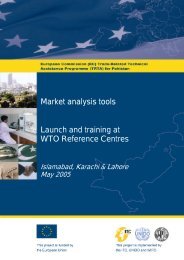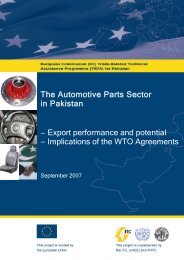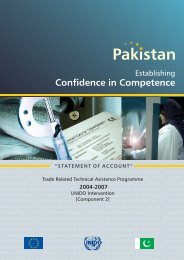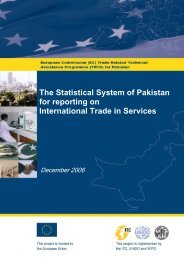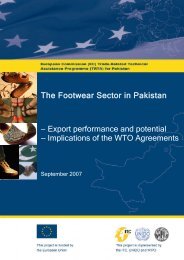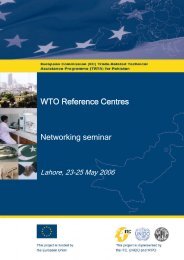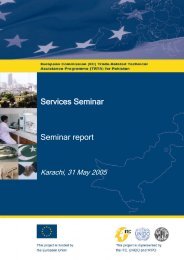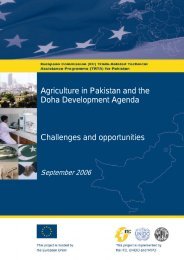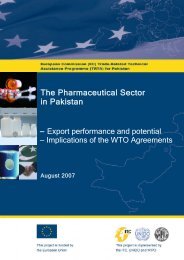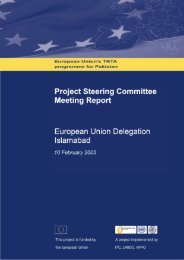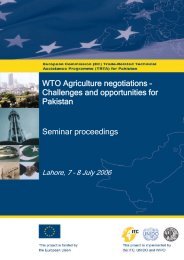The Furniture Sector in Pakistan: Export performance and ... - TRTA i
The Furniture Sector in Pakistan: Export performance and ... - TRTA i
The Furniture Sector in Pakistan: Export performance and ... - TRTA i
You also want an ePaper? Increase the reach of your titles
YUMPU automatically turns print PDFs into web optimized ePapers that Google loves.
Box 3.2 Regional Trade Agreements (RTAs)<br />
Governments often take action to liberalize trade on a regional level through formation of<br />
free trade areas or preferential trade areas. Under these arrangements, goods can enter<br />
each other’s country market either without payment of any tariff or on some preferential<br />
terms <strong>and</strong> conditions. RTA, which <strong>in</strong>cludes bilateral free trade agreements between<br />
countries that are not <strong>in</strong> the same region, have become so widespread that all but one WTO<br />
member are now parties to one or more of them. It is estimated that more than half of world<br />
trade is now conducted under RTAs. Some 197 such agreements <strong>in</strong> force have been<br />
notified to the GATT/WTO.<br />
Many experts regard these arrangements as build<strong>in</strong>g blocks for a freer non-discrim<strong>in</strong>atory<br />
multilateral trad<strong>in</strong>g system. Many other experts, however, perceive these arrangements to<br />
be obstacles to the growth of multilateral system. Regional arrangements are allowed (as<br />
exception to the Most Favoured Nation pr<strong>in</strong>ciple) under Article XXIV of the GATT 94 as well<br />
as under the Enabl<strong>in</strong>g Clause (trade arrangements between develop<strong>in</strong>g countries).<br />
<strong>Pakistan</strong> is a signatory to an Agreement on South Asian Free Trade Area (SAFTA) which is<br />
transformation of the SAARC Preferential Trad<strong>in</strong>g Arrangement (SAPTA operational albeit<br />
half-heartedly s<strong>in</strong>ce 1995) <strong>in</strong>to a Free Trade Area among the SAARC members<br />
(Bangladesh, Bhutan, India, Nepal, Maldives, <strong>Pakistan</strong> <strong>and</strong> Sri Lanka).<br />
SAFTA’s framework agreement envisages reduction of tariffs to 0-5% level <strong>and</strong> remov<strong>in</strong>g<br />
quantitative barriers to trade (a) with<strong>in</strong> 10 years by its LDCs members—Nepal, Bhutan <strong>and</strong><br />
Maldives <strong>and</strong> (b) between 7 – 8 years <strong>in</strong> case of India, <strong>Pakistan</strong>, Bangladesh <strong>and</strong> Sri Lanka.<br />
In addition to the above, a FTA has been signed with Sri Lanka. Early harvest agreements<br />
have been signed with Ch<strong>in</strong>a <strong>and</strong> Malaysia. Besides this, a FTA agreement has been<br />
signed with Ch<strong>in</strong>a <strong>in</strong> November 2006. Negotiations are ongo<strong>in</strong>g for sign<strong>in</strong>g FTA with<br />
Bangladesh, Turkey <strong>and</strong> Kenya. Discussions are also ongo<strong>in</strong>g with Indonesia, Laos,<br />
S<strong>in</strong>gapore <strong>and</strong> Thail<strong>and</strong> for explor<strong>in</strong>g the possibility of enter<strong>in</strong>g <strong>in</strong>to FTAs.<br />
Source: WTO Cell, Plann<strong>in</strong>g & Development Department, Government of the Punjab<br />
National Treatment Obligation (Article lll)<br />
Once foreign goods have entered a country’s market, these <strong>and</strong> locally produced goods are to<br />
be treated equally (as if foreign goods have acquired import<strong>in</strong>g country’s nationality).<br />
This article embodies the same pr<strong>in</strong>ciple of non-discrim<strong>in</strong>ation as set out <strong>in</strong> the MFN<br />
commitment. It also establishes the pr<strong>in</strong>ciple that no tax will be imposed on imports <strong>in</strong> excess<br />
of the amount of the <strong>in</strong>direct taxes levied on the like domestic products.<br />
Reduction <strong>and</strong> b<strong>in</strong>d<strong>in</strong>gs of National Tariffs (Articles II, XI)<br />
In order to make trade predictable, WTO member countries are generally b<strong>in</strong>d<strong>in</strong>g their<br />
commitments (Article-Xl) i.e. ceil<strong>in</strong>gs are imposed on tariff rates that can be charged by a<br />
country 12 . Under the WTO system tariffs (i.e. custom duties) are the only form of the<br />
permissible measure for trade protection (Article II & Article XI). <strong>The</strong> bound tariffs cannot be<br />
<strong>in</strong>creased above the bound rates unless compensation is paid to the other adversely affected<br />
WTO member.<br />
12<br />
<strong>Pakistan</strong> has bound more than 99% of tariff l<strong>in</strong>es.<br />
International Trade Centre 61




